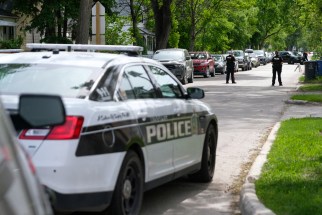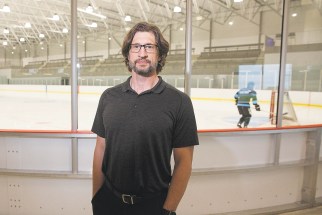Police raid Westwood home, find 3D-printed gun parts
Read this article for free:
or
Already have an account? Log in here »
To continue reading, please subscribe:
Monthly Digital Subscription
$0 for the first 4 weeks*
- Enjoy unlimited reading on winnipegfreepress.com
- Read the E-Edition, our digital replica newspaper
- Access News Break, our award-winning app
- Play interactive puzzles
*No charge for 4 weeks then price increases to the regular rate of $19.00 plus GST every four weeks. Offer available to new and qualified returning subscribers only. Cancel any time.
Monthly Digital Subscription
$4.75/week*
- Enjoy unlimited reading on winnipegfreepress.com
- Read the E-Edition, our digital replica newspaper
- Access News Break, our award-winning app
- Play interactive puzzles
*Billed as $19 plus GST every four weeks. Cancel any time.
To continue reading, please subscribe:
Add Free Press access to your Brandon Sun subscription for only an additional
$1 for the first 4 weeks*
*Your next subscription payment will increase by $1.00 and you will be charged $16.99 plus GST for four weeks. After four weeks, your payment will increase to $23.99 plus GST every four weeks.
Read unlimited articles for free today:
or
Already have an account? Log in here »
Hey there, time traveller!
This article was published 09/06/2020 (2016 days ago), so information in it may no longer be current.
Police have made an arrest and seized 3D-printed firearm components in a case they say is the city’s first, but won’t be its last.
After executing a search warrant at a home in the 100 block of West Avenue on May 20, the WPS Firearms Investigation Enforcement Unit located 28 firearms, including one prohibited. Police also found lower receivers on an AR-15 rifle and a Glock 19 handgun that had been produced by a 3D printer, with the rest of the Glock 19 having been made from bought components.
The 3D printer was also on site and seized by police.
At a media conference Tuesday, Insp. Max Waddell of the Winnipeg Police Service’s organized crime division said this was the first time 3D-printed firearms had been seized by police in the city, and he was disappointed in what he called the latest trend of “ghost guns” — or firearms manufactured with no identifiable markings to avoid tracking.
The idea that any person can obtain the materials needed to 3D-print firearm parts was “beyond concerning,” he said.
“If you can’t obtain a firearm legally because you’re a criminal, or now with COVID in place where it’s more difficult to obtain firearms from the largest manufacturer in the world, which is the United States of America, you’re going to resort to the next step, and that is making your own.”
Police do not believe the weapons seized have any gang connection, but are investigating the possibility of the suspect collaborating online, and Waddell said further charges are not off the table.
The 3D-printing process is relatively simple in theory. One of the most common ways, called fused-deposition modelling, takes a blueprint uploaded to the printer, where software splices out the object’s dimensions, and wire, usually made of plastic, is laid down in the shape of the object in the blueprint. A common comparison is that of a glue gun but being tracked so meticulously it is capable of producing a specific three-dimensional object.
While entirely 3D-printed guns do exist, police seized certain firearm components, with the rest of the weapon being made of legitimate parts.
The idea that people will begin to more regularly produce 3D-printed weapons for criminal purposes, at least with current 3D printing technology available, is a “fantasy,” according to local expert Kerry Stevenson.
“It’s quite problematic to make these things. It takes some level of skill and availability of this equipment to even attempt it, and it takes a lot of time, and the results you get is not very functional,” he said.
Stevenson, who runs the 3D-printing news site fabbaloo.com and holds a master’s degree in computer science, said there are hundreds of 3D printers in the city. And while their capabilities are improving and cost is going down, that’s the case with any developing technology, he said.
The cost of 3D-printing weapons is high. While smaller, less-functional printers can go for as little as $300, printers with the capability to create firearm parts cost thousands of dollars,” he said.
“Why would you go through all the trouble of trying to do that, when you could probably go and buy a gun off the street that actually works for less money?” he said.
Waddell said he didn’t consider the process to be highly sophisticated, noting that step-by-step instructions can be found online. A particular concern is that the guns are harder to detect because of their plastic components, he said, mentioning airport scanners as an example.
Stevenson said he disagreed with both points, noting many experiments on 3D-printed firearms even by experienced printers end in failure and most still require some metal components.
“The truth is that maybe the gun is 3D printed, but the bullets are not, and you have to have both to be able (to take) the one shot or zero shots before the thing actually explodes in your hand,” he said.
Despite the hurdles, 3D-printed guns have become a point of concern for lawmakers in the U.S. and Canada. A U.S. ruling in 2018 allowed a man to attempt to distribute 3D-printed plastic gun schematics online, but a federal judge later placed a temporary restriction on the release of the plans.
In Canada, while schematics are easily found online, it is illegal to manufacture firearms, even for personal use, without a licence.
Corey James Boyd, 31, has been charged with weapons trafficking, knowingly possessing an unauthorized firearm and not reporting a lost firearm.
malak.abas@freepress.mb.ca
Twitter: malakabas_

Our newsroom depends on a growing audience of readers to power our journalism. If you are not a paid reader, please consider becoming a subscriber.
Our newsroom depends on its audience of readers to power our journalism. Thank you for your support.
History
Updated on Tuesday, June 9, 2020 1:41 PM CDT: Updates photo
Updated on Tuesday, June 9, 2020 4:16 PM CDT: Full write-thru with additional info, extra formatting, adds photos
Updated on Tuesday, June 9, 2020 8:43 PM CDT: Byline added.






